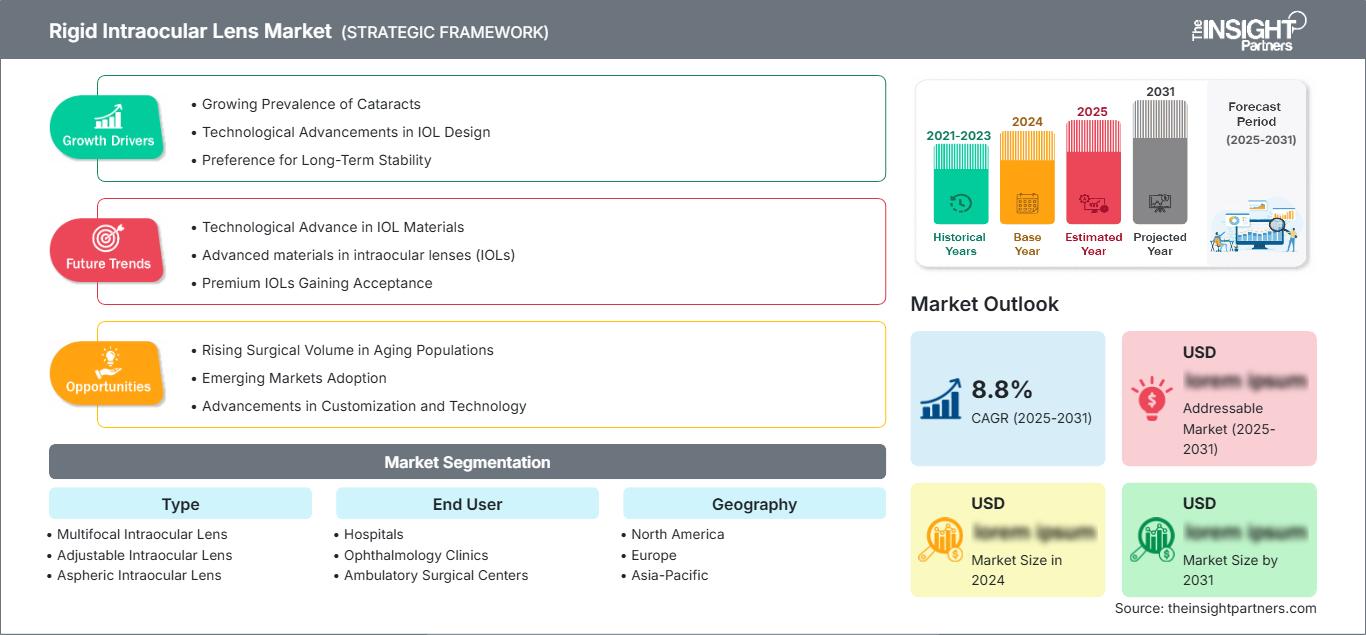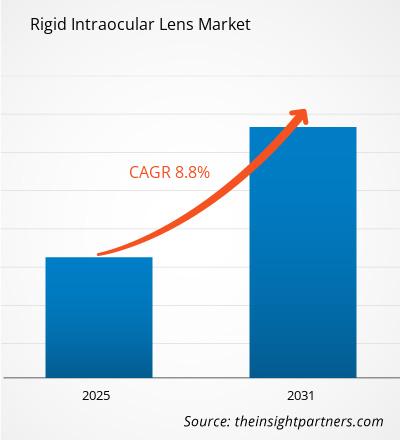页面已更新 :
Jan 2025
预计 2025 年至 2031 年期间硬性人工晶状体市场的复合年增长率为 8.8%,市场规模将从 2024 年的 XX 百万美元扩大到 2031 年的 XX 百万美元。
该报告按类型(多焦点人工晶状体、可调人工晶状体和非球面人工晶状体)、最终用户(医院、眼科诊所、门诊手术中心等)细分
报告目的
Insight Partners 撰写的《硬性人工晶状体市场》报告旨在描述当前形势和未来增长、主要驱动因素、挑战和机遇。这将为各种商业利益相关者提供见解,例如:
- 技术提供商/制造商:了解不断变化的市场动态并了解潜在的增长机会,使他们能够做出明智的战略决策。
- 投资者:对市场增长率、市场财务预测和整个价值链中存在的机会进行全面的趋势分析。
- 监管机构:规范市场政策和警察活动,旨在最大限度地减少滥用,维护投资者的信任和信心,维护市场的完整性和稳定性。
硬性人工晶状体市场细分类型
- 多焦点人工晶状体
- 可调式人工晶状体
- 非球面人工晶状体
最终用户
- 医院
- 眼科诊所
- 门诊手术中心
- 其他
自定义此报告以满足您的要求
您将免费获得任何报告的定制,包括本报告的部分内容,或国家级分析、Excel 数据包,以及为初创企业和大学提供超值优惠和折扣
硬性人工晶状体市场: 战略洞察

- 获取本报告的主要市场趋势。这个免费样本将包括数据分析,从市场趋势到估计和预测。
硬性人工晶状体市场增长动力
- 白内障患病率不断上升:由于人口老龄化和生活方式改变导致白内障病例不断增加,白内障市场正在经历显著增长,这反过来又推动了硬性人工晶状体植入的需求。这些白内障手术通常都包括人工晶状体 (IOL) 植入,而且这种手术正逐渐流行起来。人们对视力恢复解决方案的需求日益增长,因此,硬性 IOL 因其持久耐用、精准且术后仍能保持原位而成为首选。
- IOL 设计的技术进步:现有设计的持续改进或 IOL 材料应用新概念的出现是硬性人工晶状体需求增长的原因。较新的硬性 IOL 具有更高的精度、更长的使用寿命以及更好的术后视觉效果。这些改进使硬性人工晶状体成为寻求持久高效白内障手术设备的外科医生和患者的良好选择。
- 注重长期稳定性:RigIOL 是高精度人工晶状体,能够确保更长时间的稳定性。患者和外科医生都青睐这些晶状体,因为它们有助于实现理想的屈光效果,无需改变焦平面或完全更换晶状体。由于患者希望获得微创且更持久的视力矫正方案,白内障手术和屈光晶状体置换术对硬性人工晶状体的需求激增。
硬性人工晶状体市场未来趋势
- 人工晶状体材料的技术进步
- 先进的人工晶状体 (IOL) 材料:先进的人工晶状体材料是市场上另一个趋势领域。疏水性丙烯酸和波前优化设计可改善视觉效果并减少并发症。生物相容性更好,耐用性得到提高,从而开辟了更多的视力矫正选择,导致对高性能 IOL 的需求增加。
- 高端 IOL 获得认可:高端人工晶状体,即多焦点、调节和散光 IOL,需求不断增长。为了获得更好的术后视力效果,患者现在更倾向于白内障手术。它具有诸多优势,例如减少对眼镜的依赖、增强近视和远视以及矫正散光。这推动了高端人工晶状体市场向更高端的产品发展。
- 老龄人口和白内障手术的增加:随着全球人口老龄化,人工晶状体市场正在经历增长,因为白内障在老年人中最为常见。随着老年人出现视力问题,需要植入 IOL 的白内障手术率正在上升。此外,随着手术技术的进步,人工晶状体在白内障治疗中的重要性日益凸显。
硬性人工晶状体市场机遇
- 老龄化人口手术量不断上升:据统计,随着全球人口老龄化,预计全球将进行大量白内障手术,这为硬性人工晶状体 (IOL) 植入市场带来了巨大的市场机遇。这种现象在发达国家尤为明显,因为老年人更容易患白内障,因此有更多患者愿意接受 IOL 植入。企业可以通过提供可靠、制作精良的硬性 IOL 来利用这一不断增长的人口群体,从而实现其目标。B) 增加该地区的眼保健产品
- 新兴市场采用:在新兴经济体的患者比例中,由于医疗政策的改善,白内障手术的数量正在上升,低成本硬性 IOL 的机会窗口越来越大。随着经济趋势的上升以及接受白内障手术的患者增多,在对此类眼保健服务需求很大的地区,以相对便宜的价格满足患者需求的非修复性硬性 IOL 解决方案市场广阔。
- 定制和技术的进步:现有医疗器械和生物制剂的定制并不是什么新鲜事。然而,个性化医疗的日益增长的趋势为这些硬性 IOL 打开了一个利基市场。在 IOL 验配中加入光学相干断层扫描 (OCT) 和生物测量等现代技术,可以高精度地应用个体特定的晶状体植入物。企业可以利用这一领域,针对各种视觉和穿孔情况设计硬性人工晶状体,从而改善患者的体验和治疗效果。
硬性人工晶状体市场
The Insight Partners 的分析师已详尽阐述了预测期内影响硬性人工晶状体市场的区域趋势和因素。本节还探讨了北美、欧洲、亚太地区、中东和非洲以及南美和中美洲的硬性人工晶状体市场细分和地域分布。
硬性人工晶状体市场报告范围
| 报告属性 | 细节 |
|---|---|
| 市场规模 2024 | US$ XX million |
| 市场规模 2031 | US$ XX Million |
| 全球复合年增长率 (2025 - 2031) | 8.8% |
| 历史数据 | 2021-2023 |
| 预测期 | 2025-2031 |
| 涵盖的领域 |
By 类型
|
| 覆盖地区和国家 | 北美
|
| 市场领导者和主要公司简介 |
|
硬性人工晶状体市场参与者密度:了解其对业务动态的影响
硬性人工晶状体市场正在快速增长,这得益于终端用户需求的不断增长,而这些需求的驱动因素包括消费者偏好的转变、技术进步以及对产品优势的认知度的提升。随着需求的增长,企业正在扩展产品线,不断创新以满足消费者需求,并抓住新兴趋势,从而进一步推动市场增长。

- 获取 硬性人工晶状体市场 主要参与者概述
主要卖点
- 全面覆盖:本报告全面涵盖了对硬性人工晶状体市场的产品、服务、类型和最终用户的分析,提供了整体格局。
- 专家分析:本报告基于对行业专家和分析师的深入了解而编写。
- 最新信息:本报告涵盖了最新信息和数据趋势,确保了业务相关性。
- 定制选项:本报告可以根据特定客户需求进行定制,并使其与业务战略相得益彰。
因此,硬性人工晶状体市场研究报告有助于引领解读和理解行业情景和增长前景的步伐。尽管可能存在一些合理的担忧,但本报告的总体优势往往大于劣势。
- 历史分析(2 年)、基准年、预测(7 年)及复合年增长率
- PEST和SWOT分析
- 市场规模、价值/数量 - 全球、区域、国家
- 行业和竞争格局
- Excel 数据集
近期报告
客户评价
购买理由
- 明智的决策
- 了解市场动态
- 竞争分析
- 客户洞察
- 市场预测
- 风险规避
- 战略规划
- 投资论证
- 识别新兴市场
- 优化营销策略
- 提升运营效率
- 顺应监管趋势
我们的客户































87-673-9708

ISO 9001:2015



 获取免费样品 - 硬性人工晶状体市场
获取免费样品 - 硬性人工晶状体市场